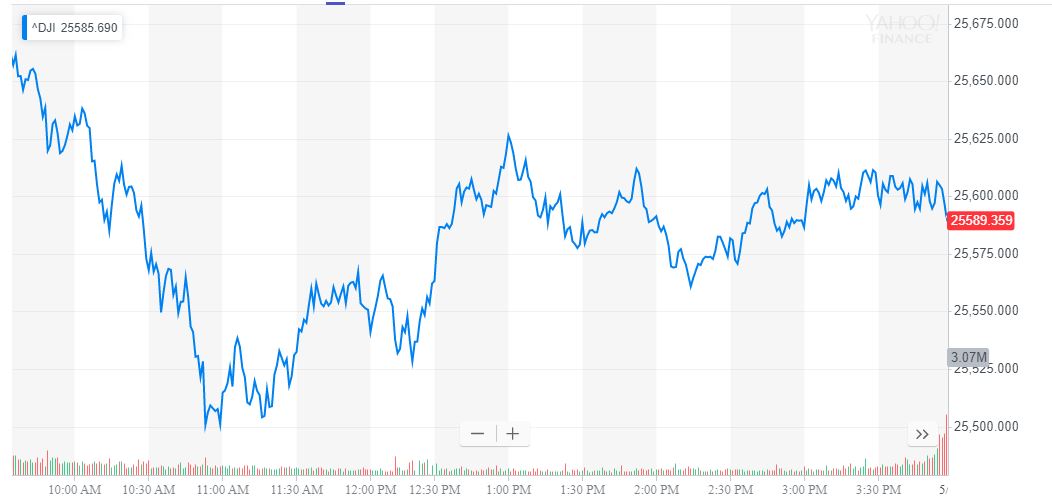Dow Blasts Higher After Trump’s Trade War Boast Stuns Markets

The Dow shot higher after Trump delivered a trade war boast that stunned Wall Street, but is he fattening the stock market on a diet of false hopes? | Source: AP Photo / Andrew Harnik
By CCN.com: The Dow shot higher on Friday after President Trump stunned Wall Street with his prediction that the trade war would be resolved unbelievably quickly.
However, as an increasingly-nationalist Beijing continues to strike an isolationist pose, is the White House fattening the stock market on a diet of false hopes ahead of a painful economic cold war?
Dow Bounces Into Recovery Mode
All of Wall Street’s major indices bounded into recovery mode on Friday, only to trim those gains later in the session.
The Dow Jones Industrial Average closed the week at 25,585.69 for a gain of 95.22 points or 0.37%. Despite the triple-digit comeback, the Dow recorded its fifth straight weekly loss; that’s its longest streak since 2011.

The S&P 500 rose 3.82 points or 0.14% to 2,826.06, and the Nasdaq climbed 8.73 points or 0.11% 7,637.01 to round out a moderately-positive day on Wall Street.
Trump Teases Unexpected End to Trade War
Stocks bounced off their May 23 lows after Donald Trump told White House reporters that he believes he can negotiate a swift end to the rapidly-escalating trade war , even as China threatens to suspend talks indefinitely until the US apologizes for its “wrong actions.”
Not fazed by Beijing’s threats, Trump teased that the Huawei controversy could be resolved under the parameters of the trade deal, potentially removing the “very dangerous” telecom giant from a US government blacklist.
“You look at what they’ve done from a security standpoint, from a military standpoint, it’s very dangerous,” Trump said in remarks at the White House. “If we made a deal, I could imagine Huawei being possibly included in some form or some part of it.”
It’s not clear on what Trump is basing his confidence, nor is this the first time the White House has swooped into calm Wall Street amid escalating trade tensions.
Bloomberg: Full-Blown Trade War a ‘Baseline’ Threat to Stock Market

According to Bloomberg , analysts now believe that a full-blown trade war is quickly becoming the “baseline” economic forecast, with the odds of a trade deal steadily moving lower.
“The US-China relationship has moved further off track over the past two weeks after a period of what appeared, on the surface, to be steady progress towards reaching an admittedly narrow agreement,” Nomura economists wrote in a note. “We do not think the two sides will be able to get back to where they seemed to be in late April.”
Nomura predicts that the trade spat will extend at least through the 2020 election, which – if Trump loses – would afford Beijing the opportunity to negotiate with a president they haven’t already lambasted as a “bully.”
Chinese government researcher Zhang Yansheng delivered an even more ominous forecast, stating that Washington and Beijing could remain engaged in trade hostilities until 2035. Seemingly affirming this bearish outlook, Xi Jinping warned China to prepare for a “new Long March” that will mire the ascendant economy in “difficult situations” for a long time.
Are Trump’s Boasts All Bluster and No Bite?

It’s striking that after a week of vicious stock market declines, Trump’s bullish commentary couldn’t manage to inspire a more feverish recovery. Could investors be growing disillusioned with the president’s China strategy?
We’ll soon find out whether Trump’s latest boast is all bluster and no bite, but for now, his stunning optimism is helping Wall Street recoup a portion of the previous session’s brutal losses.
On Thursday, all three major stock market indices slid more than 1%. The Dow crashed 286.14 points or 1.11% to end the session at 25,490.47, and its peers fared even worse. The S&P 500 plunged 1.19% to 2,822.24, and the Nasdaq had slipped 1.58% to 7,628.28 by the time the closing bell brought a merciful end to the sell-off.
Click here for a real-time Dow Jones Industrial Average price chart.